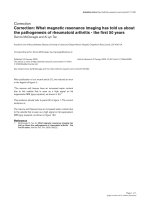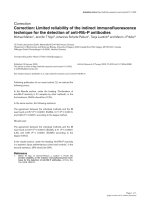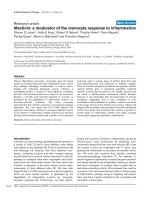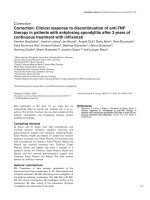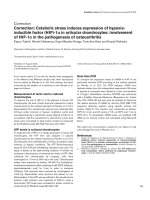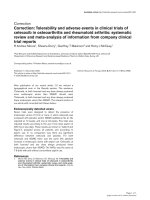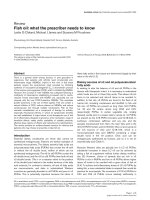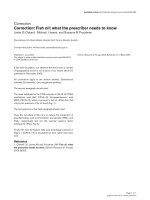Báo cáo y học: "Correction: Fish oil: what the prescriber needs to know" pptx
Bạn đang xem bản rút gọn của tài liệu. Xem và tải ngay bản đầy đủ của tài liệu tại đây (21.99 KB, 1 trang )
Page 1 of 1
(page number not for citation purposes)
Available online />It has been brought to our attention that there were a number
of typographical errors in one section of our recent article [1]
published in December 2005.
All corrections apply to the section entitled, ‘Biochemical
rationale; Eicosanoids: cyclo-oxygenase pathway’.
The second paragraph should read:
The usual substrate for the COX isozymes is the n6 LC PUFA
arachidonic acid (AA; C20:4n-6). Eicosapentaenoic acid
(EPA; C20:5n-3), which is present in fish oil, differs from AA
only by the presence of its n3 bond (Fig. 1).
The last sentence of the third paragraph should read:
Thus, the net effect of fish oil is to reduce the production of
proinflammatory and pro-thrombotic eicosanoids (PGE
2
and
TXA
2
, respectively) but not the vascular patency factor
prostacyclin (PGI
2
; Fig. 2).
Finally, the first 20-Carbon fatty acid homologue pictured in
Figure 1 (C20:3 n-9) is eicosatrienoic acid, rather than oleic
acid.
Reference
1. Cleland LG, James MJ and Proudman SM: Fish oil: what
the prescriber needs to know. Arthritis Research & Therapy
2006, 8:202.
Correction
Correction: Fish oil: what the prescriber needs to know
Leslie G Cleland , Michael J James and Susanna M Proudman
Rheumatology Unit, Royal Adelaide Hospital, North Terrace, Adelaide, Australia
Corresponding author: Michael James,
Published: 1 June 2006 Arthritis Research & Therapy 2006, 8:402 (doi:10.1186/ar1981)
This article is online at />© 2006 BioMed Central Ltd


